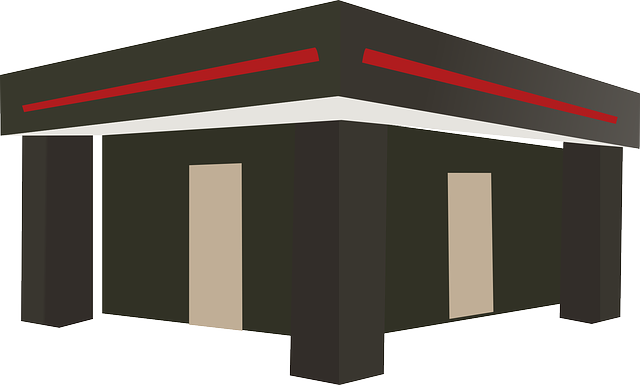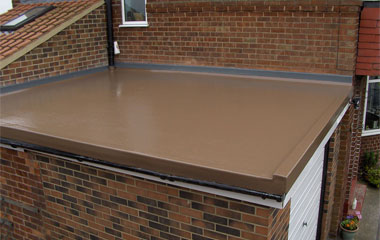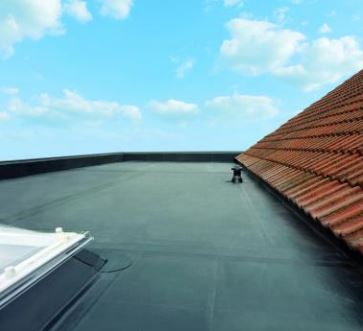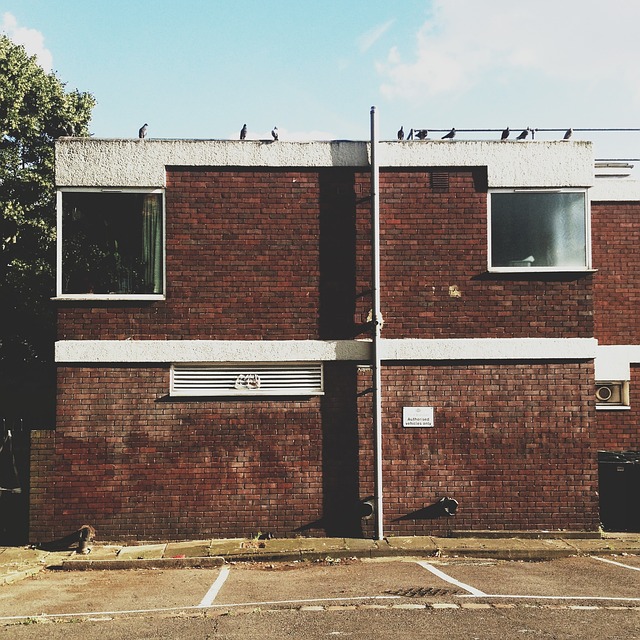Nowadays, flat roofs are much sturdier and more durable than they used to be thirty years ago.
That being said:
If yours is a bit neglected and you live in a part of the UK where heavy storms are frequent, you might have to deal with one or more flat roof leaks.
In which case you’re probably wondering:
Can you patch a leaking flat roof?
What is the best material to seal a flat roof?
And so on.
To lend a hand, at Roofing Superstore we put together an in-depth guide to your leaking flat roof repair options.
Read on to find out how to repair a flat roof.
Table of contents
- How to find a leak in a flat roof
- How do you fix a flat roof that leaks?
- Looking after your flat roof
How to find a leak in a flat roof
Before you can get to work fixing a flat roof, you’ll have to discover the source of the leak and what’s causing it.
This is generally easier to do with a flat roof than with a sloped one because water is likely to travel less far from the original entry point.
Now:
Once you’ve noticed a damp spot on your ceiling, use a measuring tape to determine how far it is from the nearest walls.
Then, go up on the roof and look for the source in the area immediately around the location. It’s best to do this on a clear day when it’s not raining.
If there’s debris, dust or leaves on the roof, make sure you clean them first so you can examine the surface. Try feeling the cleaned surface with the palm of your hand until you sense a damp spot. You’re likely to come across blisters, cracks or tears, which tend to be the chief culprits.
Having a hard time finding the source of your leaking flat roof? No need to worry! It’s time for a water test.
To do one, you can either use your garden house or bring up a bucket of water. Either way, gently pour small amounts of water where you suspect the leak to be located. Go inside the house and look at the ceiling – you should be all set.

How do you fix a flat roof that leaks?
Now that you’ve located the source of the leak, you need to assess the extent of the damage. As you’ll see in a minute, smaller, individual blisters, cracks and the like are relatively straightforward to fix.
But if you find several sources of leaks on a roof that’s getting on a bit, it’s a good idea to call the flat roof professionals. They’ll do a thorough examination and advise you whether to replace the whole roof.
Hopefully, it won’t come to that, so long as you’ve maintained your roof. In this, case you need to know the type of material the roof is made from in order to determine the appropriate flat roof repair material.
The most common types in the UK are:
Let’s take a closer look at each one.
How to repair a felt roof
Whether you have a newer, torch-on felt roof or an older, roll out one, the good news is:
Felt roof repair is quite easy.
Here’s the deal:
More often than not, you can take care of leaks and splits on your felt roof with the help of flat roof sealant for leaks. Once you’ve cleaned and dried the affected area, simply apply two layers.
Alternatively, if there’s considerable damage, you can torch-on a new layer of roofing felt. While this is a more permanent, long-term solution, it means you’ll have to be insured to work with a naked flame. If you’re not, you’ll have to call a professional.
How to repair a fibreglass roof
Glass Reinforced Polyester (GRP) flat roofs, often referred to simply as fibreglass flat roofs, are gaining in popularity thanks to their durability and aesthetic appeal.
What’s more:
Any potential splits and leaks are easy to spot early on, making fibreglass roof repair an easy DIY project in most cases. You’ll need a fibreglass repair kit, but these are easy to head gold of and quite affordable.
Once you’ve cleaned the area, read carefully the instructions that come with the kit. The process typically involves sanding with coarse sandpaper before cleaning with acetone.

Next, you’ll have to cover the area with chopped strand matting and, finally, apply a top-coloured layer. Keep in mind that there might be slight variations from one manufacturer to another.
Now:
Another common source of leaks in GRP flat roofs is flashing. Repairing a GRP roof with this issue requires you to laminate down chopped strand matting.
The process is virtually the same as the one we just outlined – clean and sand with acetone and grit paper, then laminate the chopped strand mat. Once cured, apply a topcoat matching that of the original fibreglass.
That last bit is optional, but you don’t want your beautiful fibreglass flat roof ruined by a different-coloured small patch that stands out, do you?
How to repair an EPDM roof
EPDM (ethylene propylene diene monomer rubber) or simply ‘rubber’ flat roofs are another popular choice with UK homeowners. And as with fibreglass, it’s relatively easy to repair flat roof leaks on them. If you’re not sure which one is better, you should check out our in-depth guide to EPDM and GRP roofing.

Check this out:
To fix a small tear or rip, you can apply sealant. If it’s a bigger hole, though, it’s best to go for a permanent, long-term solution from the very beginning.
Here’s what you’ll need to do:
The best option here is self-adhesive flashing tape designed for use with EPDM roofs. Start by cleaning the area before applying a suitable EPDM primer. Once it’s done curing and fully dry, use a hard roller to apply the tape, starting from the centre and working your way out.
Finally, apply a bit of sealant around the edges for extra protection and peace of mind.
Pro tip: If your rubber roof has several rips or holes in various locations, there may be a deeper issue, such as faulty installation. In that case, it’s a good idea to contact a professional as soon as possible.
How to repair a concrete roof
Surface wear and cracks are the most common causes of concrete flat roof leaks. If your concrete roof is older, natural wear and tear might disguise smaller cracks, making them harder to spot than on other surfaces, such as fibreglass.
In any event, once you’ve located the crack and cleaned and dried the surrounding area, you can go for a quick, short-term solution.
This is how to temporarily fix a leaking flat roof made from concrete:
Start by applying bitumen primer. Once you’re convinced it’s dry, liberally apply bitumen-based waterproof sealant or paint.
With a bigger crack, the best flat roof fix for the issue is to fit a sufficiently large torched-on layer of roofing felt.
How to repair an asphalt roof
With asphalt roofs, you should look for cracks and blisters. For a quick leaky flat roof repair solution, you can use self-adhesive heat-applied bitumen flashing tape once you’re done cleaning and drying.
If there are several cracks and/or blisters in the same area, it’s a good idea to go for one of the more permanent flat roof repair options. We recommend fitting torched-on roofing felt, just as you would on a felt or concrete roof. Torched-on asphalt is also a possibility.
Naturally, here too you or whoever’s doing the torching-on would have to be insured to work with naked flames.
Looking after your flat roof
A flat roof offers plenty of opportunities for recreational activities during the summer months when the sun is out.

Unfortunately, it can also retain rainwater and sustain damage from excessive dirt, debris, leaves and so on.
The thing is:
It’s absolutely crucial that you look after your flat roof properly. Inspect it on a regular basis for cracks, blisters, general wear and tear and anything else that might cause any leaks.
Once you’ve detected any, make sure you carry out the necessary leaking flat roof repair projects straight away, weather permitting.
Whatever the type of roof, there’s always a quick temporary roof leak fix, which typically involves sealing flat roof leaks. Make sure you do that before moving onto a permanent one.
Bottom line:
Look after your flat roof, and it’ll look after you during the stormy season.














